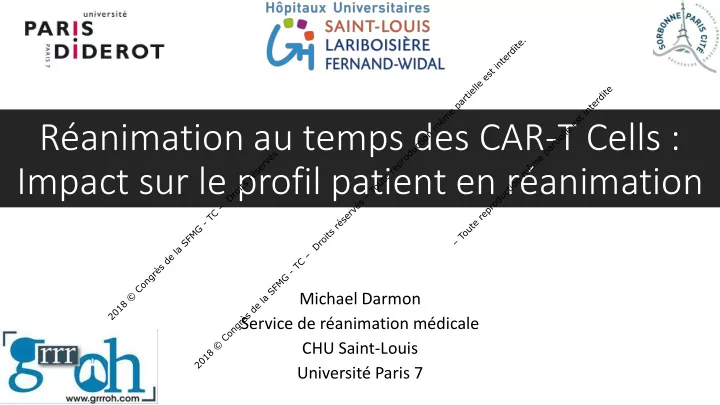

Réanimation au temps des CAR-T Cells : Impact sur le profil patient en réanimation Michael Darmon Service de réanimation médicale CHU Saint-Louis Université Paris 7
Conflits d’intérêts ▪ Research grants: MSD, Astute medical ▪ Speaker fees: MSD, Astellas, Bristol Myers Squibb, Gilead ▪ Support in organizing educational meetings: MSD, Astellas, JazzPharma ▪ Advisory board: Sanofi Aventis, Gilead-Kite
CAR-T: a potential « game changer » Neelatu et al. N Engl J Med 2017; Haartman et al. EMBO 2017
CAR-T: A limited experience 2017: ~ 400 CAR-T patients reported 2/3 with anti-CD19 CAR-T Haartman et al. EMBO 2017
CAR-T: an exponential progression Haartman et al. EMBO 2017
CAR-T Cells recipients and ICU
Half CAR-T Cells recipients will require ICU • CAR-T Anti-CD19 • 133 patients (47 ALL, 24 CLL, 62 NHL) Stage 2+ sepsis ICU Admission Hay et al. Blood 2017
Half CAR-T Cells recipients will require ICU • Early CRS = severe CRS • Severe CRS = Neuro toxicity Hay et al. Blood 2017
Expect CRS but assume Sepsis • Cumulative rate of infection ~40-50% • High rate of viral and fungal infection Adjusted ratio of infection density ALL>CLL>LNH (Ratio 2.7 and 4.4) Prior regimen >4 (Ratio 3,5) Dose >2*10 7 (Ratio >7) Hill et al. Blood 2018
Expect CRS but assume Sepsis • No reporting of adjusted risk (collinearity) • Risk factors as usual in high risk patients CAR-T cells dose Neutropenia Severity Hill et al. Blood 2018
Expect CRS but assume Sepsis • Some patients misleadingly classified as “CRS” Hill et al. Blood 2018
Expect CRS but assume Sepsis • Some patients misleadingly classified as “CRS” Rate 42% 30% 13% 10% 8% 6% 6% Any Bacterial Including BSI Fungal Including Viruses Including RV infection mold Hill et al. Blood 2018
CAR-T cells as source of MOF Brudno et al. Blood 2018
How to prepare for CAR-T in ICU
Anticipation of ICU admission • ICU team is informed of every CAR-T infusion • ICU involved in older potential recipients / Comorbid patients • Grade 2 CRS/NT requires ICU admission • Grade 2 CRS/NT should be treated as sepsis • Specific therapies (Anti-IL6/Steroids) are validated collegially SOP Saint-Louis
Identification of high risk patients Hay et al. Blood 2017
Early fever or high fever= severe CRS Hay et al. Blood 2017
Early ICU Admission • General population of Critically Ill Cancer Patients Hourmant et al. Soumis
Early ICU Admission • Poor reliability of severity assessment, increased mortality of late admission 1 Lack of severity mortality 8.5% 0.8 ICU admission mortality 45.7% 0.6 late ICU admission 0.4 mortality 61.5 % Futility 0.2 Mortality 75% 0 Days 0 5 10 15 20 25 30 Thiery et al. J Clin Oncol 2007
Multidisciplinary round is the rule
Pitfalls
Beware limits of current CRS staging • Example: CTCAE definition of AKI less stringent than consensus definition • CTCAE kidney dysfunction stage 2 = severe AKI (KDIGO stage 3) • To reach AKI stage 1 (+26μmol sCreat or +50%): • 5 to 10 hours with > 40% decrease in GFR • AKI stage 1 = +50% short term mortality • AKI stage 1 = increased risk in readmission, long term mortality, and CKD Porter et al. J Hematol Oncol 2018
Saint-Louis University Hospital
Our experience 33 CAR-T 60% NHL ICU admission n=13 (40%) 5 Neuro T (36%) 12 CRS 2+ (93%) including 3 NT grade 3/4 Including 4 CRS 3-5 5 with concurrent CRS (100%) 4 Sepsis 2 with microbio doc.
Our experience • ALL-B = 9 Pts/13 • Anti-IL6 systematically required • Steroids required in 2/3 of ICU CAR-T patients • Confirmed sepsis in 1/3 of ICU CAR-T patients • Septic patients may reach apyrexia after Toci • 2 early deaths (<15 days) • 4 Early failures
Take home message
Before CAR-T • Be available for trials kick-off / institution selection • Assessing performance status • Assessing overall risk of ICU admission • Introducing ICU team to the patients and their next of kin • According to institution processes • Monitoring during apheresis
Day of CAR-T infusion • Be available • Record day of infusion / anticipate ICU admission • Early evaluation by outreach team if fever • Early ICU admission • High risk patients • Early CRS + minimal organ dysfunction • CRS stage 2 or more: Assume sepsis and ICU admission
After ICU admission • Antibiotics systematically • Antifungal therapy if needed • Anti-IL6 if CRS • Steroids : severe CRS and Neurotoxicity • Multidisciplinary rounds • Adjust according to trials
Conclusion • Potential game changer • A high number of potential recipients • A high rate of ICU admission • A high rate of sepsis to be expected • CRS stage 2: 50% chances of infection • Early ICU admission since predicting ”clinical worsening” is unreliable • Multidisciplinary rounds because we care for our patients
Merci de votre attention
Recommend
More recommend